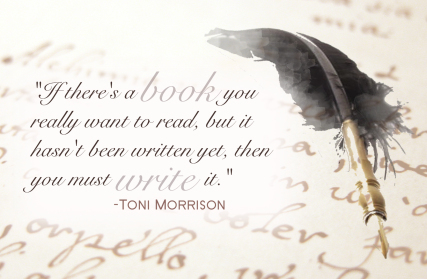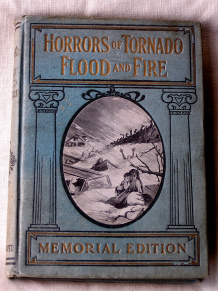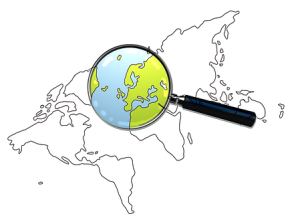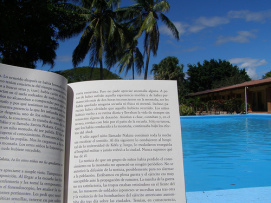J.K. Ullrich's Blog, page 30
June 10, 2015
Environmental Hazards: Five Challenges of Writing Climate Fiction (Part 7)
This post concludes a seven-part series discussing my experience writing climate fiction in my novel, Blue Karma .
Conclusion
Over the past week, I’ve shared the five greatest challenges I encountered writing the cli-fi genre: turning a vision into a narrative, defining the scope and thematic focus of the story, drawing inspiration from current events, and avoiding rhetoric. Each of these aspects presents its own traps and tricks. However, I found one overarching consideration helped me overcome most of these environmental hazards. The secret? It’s really not a secret at all, but a basic principle of fiction. Write a solid story.

This excellent advice from an exceptional writer applies to all genres, including cli-fi.
Good writing craft transcends genre. In any novel, readers expect a logical plot, dynamic characters, and a satisfying story arc. Climate fiction is a form of realism, so why approach it as a totally alien concept? Yes, the speculative elements make it a bit more complicated and require careful handling. But a cli-fi writer’s ultimate goal mirrors that of any other author: telling an engaging, believable story. To borrow from Hamlet, “the play’s the thing”. If you focus on crafting a high-quality narrative, many of cli-fi’s specific issues will fall in line.
For my own part, I appreciated how cli-fi forced me to pay more attention to writing technique. My skills definitely improved as a result from the experience. Plus, it was a lot of fun! The genre’s balance of reality and imagination provides a unique storytelling palette. Blue Karma represents my first plunge into cli-fi, but I doubt it will be my last.

June 9, 2015
Environmental Hazards: Five Challenges of Writing Climate Fiction (Part 6)
This post is part six of a seven-part series discussing my experience writing climate fiction in my novel, Blue Karma .
Challenge #5: Step Away from the Soapbox
As both a writer and a bibliophile, I think the greatest power of fiction is its ability to provoke thought. Here the cli-fi genre has a clear mission. Less than half the American public acknowledges the human impact on the climate, according to a 2014 Pew Research center poll, and only 33% consider it a serious problem. Changing these minds is critical to addressing climate change before it’s too late. If the increasingly disastrous headlines discussed in the last post don’t sway them, perhaps a good story can.

Readers want good stories, not propaganda.
That doesn’t mean cli-fi should become an author’s soapbox. On the contrary: stuffing your story with rhetoric will probably turn off even those readers who share your view. Readers aren’t stupid. They can discern between a story with a strong theme and a flimsy narrative used as a vehicle for propaganda. It’s sort of like the difference between orange juice and orange cough syrup: both have an identifiable flavor, but one is natural while the other is cloyingly artificial and leaves a bad taste in your mouth.
Despite my own strong convictions on environmental issues, I tried hard to keep Blue Karma free of politics. On the first revision, I removed any scenes or dialogue that seemed ideologically heavy-handed. I found it useful to keep the plot tightly bound to my characters’ immediate lives. For them, the causes of climate change are irrelevant: it’s simply the ecological reality they have to endure. Letting them direct the narrative helped eliminate my own opinions from the story. My goal in the book was not to assign blame for climate change or condemn those deemed responsible: I only wanted to portray, as convincingly as possible, what our world might look like if water crises continue to worsen. If I did my job right, this vision will speak for itself and readers can infer their own messages.
*Addendum, 11 June 2015: A family member who identifies as a conservative and climate change skeptic just finished reading Blue Karma. Given how much his beliefs differ from mine, I expected Blue Karma wouldn’t be his type of book. He admitted he was “wary that this was going to be another Fern Gully” (which made me laugh, since that was one of my favorite movies as a kid). But he enjoyed the story on its own merits and thought I avoided the pitfalls of preaching discussed in this post. Hearing his feedback meant a great deal to me. In writing Blue Karma, I tried to create a story that readers could appreciate regardless of their personal ideology, and my family member’s comments indicate I succeeded. Here’s to putting plot before politics!
Avoiding overwrought ideology is probably the biggest obstacle of writing cli-fi, but it can be overcome in much the same way as the other challenges discussed in this series. What’s the unifying theme? We’ll talk about that in the conclusive installment of Environmental Hazards.

June 8, 2015
Environmental Hazards: Five Challenges of Writing Climate Fiction (Part 5)
This post is part five of a seven-part series discussing my experience writing climate fiction in my novel, Blue Karma .
Challenge #4: The Headline Tango
Writing Blue Karma felt like a race against time. Over the year it took me to finish it, more and more headlines about epic droughts , floods, and changing attitudes about water use peppered the news, almost mirroring the progress of the story. You’d better hurry up, I told myself as I typed, before you have to switch genres to non-fiction! Part of climate fiction’s appeal is how closely it flirts with reality. It whispers in the ear of today and makes dire promises about tomorrow. This forces cli-fi writers into a precarious tango with the daily headlines: the performance demands we dance entwined, but make sure you, not the news, lead the steps.

Current events provide critical inspiration for cli-fi, but don’t try to include everything (this, by the way, is a real event that occurred in 1919).
Current events can provide lots of inspiration. For example, after hearing about migrants trapped on ships off the coast of southeast Asia, I incorporated a similar experience into Amaya’s backstory. It fit perfectly into her narrative and developed a part of her history that had previously felt like an afterthought. Hunting for small gems like this can make the news addicting for cli-fi writers, but it’s also distracting. Towards the end of my project, I had to stop reading news about the California droughts because every report temped me to rework my story and accommodate the new development. If I’d tried to update the draft with every relevant news item I encountered, I’d never have finished it. Worse yet, it might’ve ended up reading like a pastiche of fictionalized headlines rather than a creative, cohesive work of my own invention.
Relying too heavily on headlines or cramming too many references into the plot can derail your story: when headlines lead the tango, it’s easy to trip and fall, and lose all momentum. I discovered current events are best used as raw material for broad trends, which the writer can then extrapolate for a portrait of how those things might look in the future. Cli-fi may be realism, but don’t forget it’s still fiction. It’s acceptable to craft your own details….just be mindful of how you craft your own opinions, the penultimate topic in the Environmental Hazards series.

June 7, 2015
Environmental Hazards: Five Challenges of Writing Climate Fiction (Part 4)
This post is part four of a seven-part series discussing my experience writing climate fiction in my novel, Blue Karma .
Challenge #3: Choose-Your-Own-Apocalypse

Be selective when choosing climate disasters for your story: this book doesn’t need a sequel.
Our present environmental situation offers a smorgasbord of cataclysms for writers to employ: air pollution; mass extinctions; ultraviolet rays roasting us through holes in the ozone layer; a rise in mosquito-borne disease as regions grow wetter and warmer. Temping as it is to combine crises, too many disasters can make your story jumbled and overwrought. The tale of characters in a sinking city who try to combat air pollution while under siege from solar radiation zombies isn’t very…hey, I just found the plot for my next book! Just kidding. I’m not saying it couldn’t work, but stories that overblown risk compromising their plausibility. And as we discussed in part three of this series, cli-fi is most effective when it is believable.
Juggling multiple calamities also diminishes your opportunity to explore their respective effects. In the book Oryx and Crake, for example, Margaret Atwood postulates the dire consequences of genetic engineering. If she had tried to examine simultaneously the issue of global hunger or sea-level rise, it would probably have muddled the story’s theme and impact. Other problems can be implied–such as in Blue Karma, when I include smog in my description of a city to suggest air pollution–but emphasizing too many of them in the narrative makes the story feel like a bad disaster movie rather than a thoughtful cli-fi novel.
Focusing on one main issue allows the writer to plumb ideas more deeply and cultivate more nuanced layers of causality. With all the climate-related crises in our world today, why cram them all into one story? Each merits thorough examination its own right. Sadly, there’s no shortage of material to choose from; just read the news. But read with caution…I’ll tell you why in the next installment.

June 6, 2015
Environmental Hazards: Five Challenges of Writing Climate Fiction (Part 3)
This post is part three of a seven-part series discussing my experience writing climate fiction in my novel, Blue Karma.
Challenge #2: Scope and Scale
Cli-fi works because we can identify with it. It’s our own world, reflected in a warped mirror of environmental armageddon. If I’d set Blue Karma on a distant planet, it wouldn’t have the same opportunity to resonate with readers who have felt a misty Seattle breeze, or walked the furrowed earth of the San Joaquin valley. Showing readers drastic changes in the world they know makes the message of cli-fi truly visceral.

Focusing the scope of your cli-fi story makes for a richer, more believable setting.
Let me tell you a secret. My original concept for Blue Karma was a collection of vignettes describing water crises all over the planet. It would have illustrated the global nature of the crisis I’d imagined, but at a somewhat superficial level. Ultimately I scratched the idea because I didn’t think that style of storytelling would allow me to develop conflicts and characters as thoroughly, or show the depth of impact on communities. Instead I corralled the plot into a handful of locations—ones I thought many readers would recognize—and examined how my theme reshaped lives in those places.
Think of it in terms of biology. Within the large biomes of realism and science fiction, you can cultivate a thriving niche ecosystem of cli-fi. Don’t be afraid to stay small. Barbara Kingsolver’s Flight Behavior deals with ecological issues that play out in a rural Tennessee town, while Paolo Bacigalupi’s The Drowned Cities takes place in a half-sunken future version of Washington, DC (the latter struck me because I’d worked in DC for several years and could easily envision the changes, which kind of proves my point). I found narrowing my scope made for a richer, more believable cli-fi setting. This principle of selectivity also applies to a writer’s choice of catastrophes….which I will discuss in the next segment.

June 5, 2015
Review of “Blue Karma” on emdoesbookreviews
I recently sent a promo copy of Blue Karma to the delightfully articulate Emma, avid reader behind the emdoesbookreviews blog. She posted her review today. I’m not ashamed to admit, I’m thrilled: not only did she enjoy the book, she provided some of the most comprehensive feedback I’ve gotten since completing the manuscript, which is tremendously helpful. Emma, thanks so much! I encourage anyone curious about my story to read her thorough (and author-verified spoiler-free) review. While you’re there, check out her other book reviews and expand your summer reading list.

Environmental Hazards: Five Challenges of Writing Climate Fiction (Part 2)
This post is part two of a seven-part series discussing my experience writing climate fiction in my novel, Blue Karma.
Challenge #1: Packaging Prophecy
Sometimes I think “science fiction writer” is a euphemism for “hack prophet”. We see the future in our mind’s eye and set down the vision before it comes to pass. But a setting is not a story. Readers need more than a guided tour of our alternate reality: they need engaging characters and a sufficiently compelling narrative to keep them turning pages.

The cli-fi crystal ball can show how our environment has been turned upside-down…but a good story needs more than a vision.
Imagine if Hugh Howey’s blockbuster novella Wool spent whole chapters describing the silo and its workings in excruciating detail. It wouldn’t be a story so much as a technical manual. Few readers would get excited about that. Howey’s story worked because he populated his silo with dynamic characters who acted upon relatable motives. He wove the ambient realities of his imagined world into their experiences.
Character placement is the best way I’ve found to showcase a cli-fi “vision” organically. In Blue Karma, each of the three protagonists occupies a position where the cli-fi landscape impacts their daily lives; however, I let their simple human motives drive the plot. Amaya steals water to provide for herself and her sister, the only family she has left after a freak weather event destroyed her country. Logan’s deployment to guard water reserves seems wasted when he discovers his hometown on the verge of desertification. Paul, whose water company controls the fate of millions, feels torn between winning his mother’s approval and acting ethically. Placing my narrators at ground zero allowed me to explore an imagined water crisis without ever leaving the storyline.
See what I mean? Wool is really about a man devastated by the loss of his wife. Blue Karma is really about three teenagers struggling with issues of survival, responsibility, and love. Never forget that a fiction author’s primary objective is to tell a story. If you get too caught up describing the workings of your predicted future, you risk losing the plot—literally. This is true of science fiction in general, but I think it’s especially applicable to cli-fi. Because cli-fi is a sort of environmental “prophecy”, you want to maximize its impact on readers. Nothing accomplishes this better than introducing a character readers will root for (or against) and showing how ecological problems affect that character’s goals.
A second tactic for making your “prophecy” effective is to ensure your cli-fi world is still recognizable as our own. I’ll discuss this in part three of Environmental Hazards.

June 4, 2015
Environmental Hazards: Five Challenges of Writing Climate Fiction (Part 1)
Climate fiction, like the global average temperature, is on the rise. If you haven’t heard of this genre, you’re probably not the first. Themes of climate change and ecological disaster have appeared in contemporary fiction since the mid-20th century, but the concept of these as an independent genre is relatively new. The term climate fiction appeared in 2007, usually attributed to journalist Dan Bloom, but took some time to catch on. Not until 2013 did “cli-fi” earn some mainstream attention, featuring in articles from NPR and The Guardian.
An increasing number of books are venturing into cli-fi’s semi-dystopian territory. A few I would categorize as such include Oryx and Crake by Margaret Atwood (who, incidentally, endorsed the term cli-fi in 2010) The Drowned Cities by Paolo Bacigialupi, and my own debut novel, Blue Karma. More than just fantastical entertainment, I believe cli-fi can raise public awareness of a critical issue, much as Upton Sinclair’s The Jungle exposed conditions in the meat-packing industry, or Charles Dickens’ work addressed child labor in industrial England. Our stories reflect our society, and the expansion of cli-fi evidences growing concern for our planet’s future.
*Update, 5 June 2015: Dan Bloom, the journalist who coined the term cli-fi, reached out to me and offered some interesting insights on the genre. He does not consider it part of the science fiction family at all, but an independent form of realism. While science fiction relies on imaginary future technologies for its narratives, such as the faster-than-light travel or sentient AI, cli-fi draws from the realities of Earth-based climate change. I had always thought of cli-fi as a subset of science fiction, I suppose, because contemporary literature often combines elements of the two. But after hearing Mr. Bloom’s argument, I have to agree that cli-fi deserves recognition as speculative realism. I think it can easily step into the realm of science fiction, but–as news headlines increasingly indicate–climate and environmental issues are anything but imaginary.
Breaking ground in a new literary trend is exciting, and I feel privileged to help establish cli-fi among readers. Rooted in realism rather than pure invention, cli-fi demands a unique marriage of imagination and gritty believability. Over the next week, I’ll feature a series of posts discussing the challenges I encountered while writing cli-fi and how I overcame them. I certainly don’t claim to be an expert, but in a budding genre, who is? I hope sharing my experiences will help introduce cli-fi to a broader audience and give aspiring writers a guide as they explore this new realm of fiction.

June 2, 2015
Those who are about to be reviewed salute you
Yesterday’s free book promotion resulted in more downloads of Blue Karma than I anticipated! I compulsively refreshed the sales report all day long, watching the line graph expand to steeper and steeper angles. I don’t know nearly that many people, so it wasn’t just the friends and family I nagged into picking up a copy. My shameless advertisements on Amazon’s author forums must’ve worked. As a means of exposure, the promotion proved highly effective.
The good news? 75 people are now reading my novel.
The bad news? 75 people are now reading my novel.
It seems contradictory, I know. The whole object of publishing a book is to have others read it. But for an indie author making her debut, the excitement of new readership comes shadowed with anxiety. When those 75 people begin posting reviews (and I hope many of them will) their ratings could determine the fate of my writing launch.
General approval would provide a great foundation on which to continue building my author platform. An unfavorable reception, however, would hinder not only the success of Blue Karma, but my subsequent books (I’m already working on my second one). So in my imagination, those 75 readers look something like this:

My draft readers all enjoyed Blue Karma, but are they representative of the larger Kindle-reading demographic? I’ll just have to wait and see. And I’ve never been a patient person. No matter which way the thumb falls, I’m proud of having completed my first novel. “Exegi monumentum aere perennius,” as Horace said: I have erected a monument more lasting than bronze. In the Stygian mire of the internet, my ebook becomes immortal. Yikes. That thought is even scarier than the judgment of the 75!

May 30, 2015
“Blue Karma” free book promotion
 Technically the summer solstice is June 21, but I always think June sounds like summer, don’t you? So let’s jump-start June with some poolside reading.
Technically the summer solstice is June 21, but I always think June sounds like summer, don’t you? So let’s jump-start June with some poolside reading.
On Monday, June 1, Blue Karma will be available for free on Amazon.
At the risk of sounding like an infomercial announcer, this is a limited-time offer! Order now and we’ll also send you a Snuggie! Just kidding about that last. But I am indeed running a free book promotion for my debut novel on June 1. That’s only two days away. Don’t miss your chance to score a page-turning adventure story for your summer escape.





